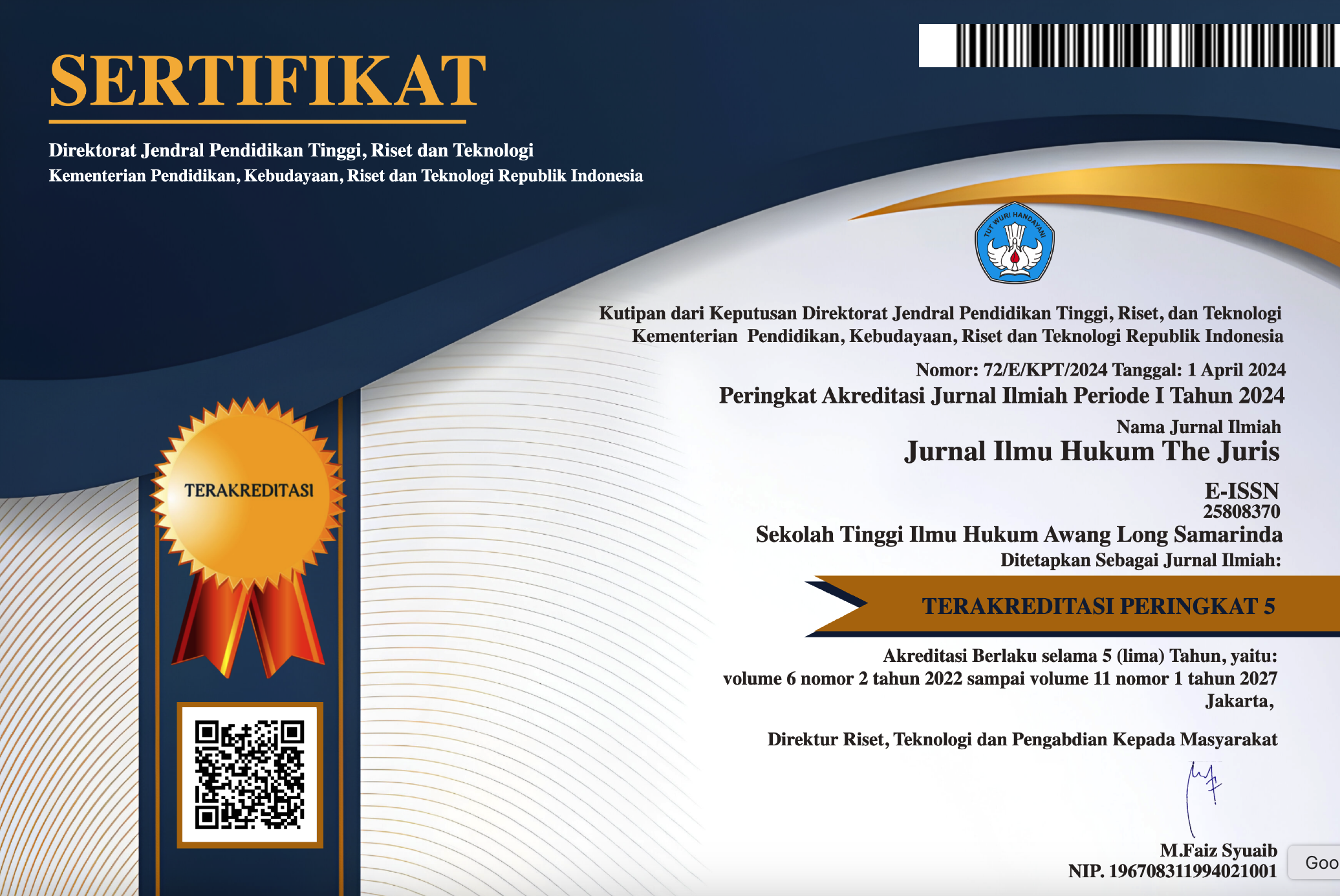PERTANGGUNGJAWABAN PIDANA BAGI PENGIDAP NECROPHILIA DALAM TINDAK PIDANA PEMERKOSAAN MAYAT
Abstract
This research examines necrophilia as a sexual orientation deviation that has not been regulated in the National Criminal Code. The National Criminal Code Article 271 focuses on corpses, digging up or dismantling graves, taking, moving or transporting corpses and treating corpses in an uncivilized manner while the rape of corpses is not regulated in the National Criminal Code. Thus, there is a legal vacuum. This is a new problem because the status of necrophilia is mentioned as a form of disease so how is the form of responsibility. The purpose of this study is to find out how the regulation and form of criminal liability for perpetrators who have necrophilia in the crime of corpse rape. The research method used in this writing is juridical-normative legal research, using a statutory approach in order to discuss legal issues in this research. The results of this study found that criminal liability for people with necrophilia in the crime of corpse rape is basically not clearly regulated in the new Criminal Code. From the perspective of criminal acts, it is regulated in Article 271 of Law Number 1 Year 2023 (National Criminal Code) and from the perspective of the crime of rape, it is formulated in Article 415 of the National Criminal Code. While the crime against the corpse itself is regulated in Article 415 of the National Criminal Code and Article 271 of the new Criminal Code, Article 269 of the National Criminal Code and Article 270 of the National Criminal Code.
Downloads
References
Aggrawal, A. (2009). A New Classification of Necrophilia. Journal of Forensic and Legal Medicine, 16(6), 316–320.
Krueger, R. B., Reed, G. M., First, M. B., Marais, A., Kismodi, E., & Briken, P. (2017). Proposals for Paraphilic Disorders in the International Classification of Diseases and Related Health Problems, Eleventh Revision (ICD-11). Archives of Sexual Behavior, 46(5), 1529–1545.
Aggrawal, A. (2014). Textbook of Forensic Medicine and Toxicology. Avichal Publishing Company.
Agrawal, A. (2016). Necrophilia: Aspek Forensik dan Medico-Legal. Pers CRC.
Amrani, H., & Ali, M. (2015). Sistem Pertanggungjawaban Pidana (Pertama.). Jakarta: Rajawali Pers.
Hamzah, A. (1999). Asas-asas Hukum Pidana. Bandung: Rineka Cipta.
Holyone, M., Singamedja, N., Senjaya, O., & Pura, M. H. (2019). Hukum Pidana Indonesia. (H. Adhi, Ed.). Jakarta: Sarana Nusantara.
Huda, C. (2006). Dari Tiada Pidana Tanpa Kesalahan Menuju Kepada Tiada Pertanggungjawaban Pidana Tanpa Kesalahan. Jakarta: Kencana Prenada Media.
K, R. (2007). Semua Tentang Nekrofilia. Perpustakaan Kejahatan. Jaring.
Kanter, E. Y., & Sianturi, S. R. (2002). Asas-Asas Hukum Pidana di Indonesia dan Penerapannya. Jakarta: Storia Grafika.
Lamintang. (1984). Dasar-dasar Hukum Pidana Indonesia. Bandung: Sinar Baru.
Lamintang. (1997). Dasar-dasar Hukum Pidana Indonesia. Bandung: Citra Aditya Bakti.
Marzuki, P. M. (2021). Penelitian Hukum. Jakarta: Kencana.
Moleong, L. J. (2002). Metodologi Penelitian Kualitatif Edisi Revisi. Bandung: Remaja Rosdakarya.
Robin, G., & Duncan, C. (2002). Hubungan Yang Tidak Pantas: Yang Tidak Konvensional, Yang Tidak Disetujui, Dan Yang Terlarang. Inggris: Pers Psikologi.
Syamsudin, M. (2021). Mahir Meneliti Permasalahan Hukum. Jakarta: Kencana.
Undang-Undang Nomor 1 Tahun 2023 tentang Kitab Undang-Undang Hukum Pidana (KUHP Nasional).
World Health Organization. (1965). ICD-8 international statistical classification of mental and behavioural disorders. World Health Organization. Geneva.
World Health Organization. (1977a). International Classification of Diseases (1975 Revis.). Geneva: World Health Organization.
World Health Organization. (1977b). International Classification of Diseases. World Health Organization (1975 Revis.). Geneva: World Health Organization.
World Health Organization. (1992). ICD-10 international statistical classification of diseases and related health problems (10 Revisio.). Geneva: World Health Organization.
The ICD-9-CM (Clinical Modification), which was in use until October 1, 2015, in the USA, is an adaptation of the ICD-9 for clinical use in the USA, originally published in 1979. U. S. N. C. for H. S. (2011). International Classification of Diseases,Ninth Revision, Clinical Modification (ICD-9-CM).” Centers for Disease Control and Prevention. Centers for Disease Control and Prevention. Retrieved from http://www.cdc.gov/nchs/icd/icd9cm.htm
Copyright (c) 2024 Vania Romasta Siahaan, Gita Rismawati, Mardian Putra Frans

This work is licensed under a Creative Commons Attribution-ShareAlike 4.0 International License.







